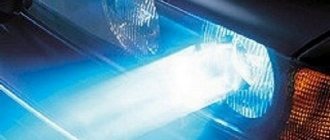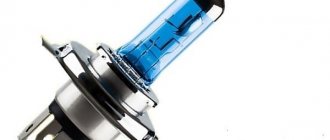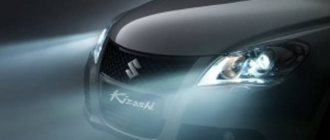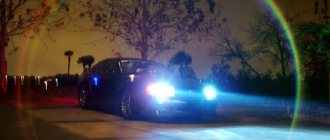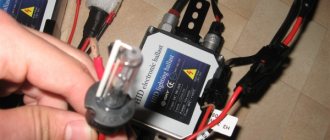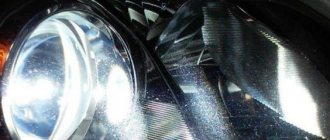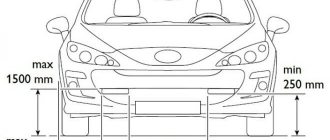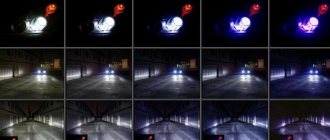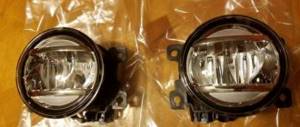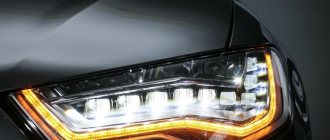Headlights with xenon (gas discharge) lamps provide greater illumination of the road, which helps reduce accidents in the dark or in poor visibility conditions.
Dear readers! The article talks about typical ways to resolve legal issues, but each case is individual. If you want to find out how to solve your particular problem , contact a consultant:
+7 (499) 938-81-90 (Moscow)
+7 (812) 467-32-77 (Saint Petersburg)
8 (800) 301-79-36 (Regions)
APPLICATIONS AND CALLS ARE ACCEPTED 24/7 and 7 days a week.
It's fast and FREE !
Is it possible to install such lighting devices on any vehicle and how to legalize the conversion of a car, read on.
If necessary
In accordance with the annex to Government Decree No. 1090, operation of a vehicle is prohibited if the vehicle is equipped with headlights that do not comply with the design.
This means that xenon can be installed on a vehicle:
- having headlights marked DR, DC or DCR;
- on headlights, if the design of the car provides for automatic leveling and washer of lighting equipment.
In all other cases, the installation of xenon is illegal, and the car owner can be held administratively liable under Article 12.5 of the Administrative Code.
The penalty under this article is deprivation of a driver’s license for a period of 6–12 months.
The correctness of lighting is checked by a traffic police inspector at a stationary or mobile post with special equipment.
The decision to impose fines and deprivation of rights is made by the court after receiving the appropriate conclusion from traffic police officers.
However, the re-equipment of a vehicle, including the installation of xenon headlights, can be legalized.
This means that after all changes have been made to the vehicle and the design requirements have been checked, any driver can use lighting devices with a brighter luminous flux.
Head optics parameters
A vehicle should not be allowed to operate without functional front headlights. This is one of the mandatory conditions for the vehicle to enter public roads. Head light optics help provide driver visibility even in difficult weather conditions .
Like any part of a car, headlights are a rather complex device. Its main elements are:
- the body to which the remaining parts are attached;
- a lamp of some type used as a light source;
- reflector, presented in the form of a radius polished mirror surface;
- glass with a smooth or corrugated surface;
- cartridge for fixing the lamp;
- wiring for connection and connection.
Certain processes occur in a lensed headlight. Namely:
- in the first focus there is a reflector that receives the light beam directed by the lamp;
- a reflected beam of light comes out through the lens;
- Excessive reflected light fluxes can be limited due to built-in curtains, which help to form a beam more accurately directed in a specific direction.
In fact, optics with lenses can be found in different areas of the car. More specifically, we are talking about the following:
- high or low beam;
- fog lights;
- turn signals;
- reversing lights.
It is important to know that the “Angel Eyes” option in the form of white circles helps improve the appearance of lighting fixtures with built-in lenses.
Where to contact
How to legalize xenon in headlights? First of all, it is necessary to obtain appropriate permission from a specialized organization (NAMI or any other company that has permission to engage in relevant activities) regarding the possibility of installing new lighting devices on a specific car.
Examination of a vehicle is carried out for a fee (approximate cost 4,000 rubles ).
To obtain a preliminary examination, a written application is submitted to NAMI (automotive product certification body), which indicates:
- Full name of the director of the institution to whom the application is being submitted;
- Full name and residential address of the car owner;
- make and model of the car to be converted;
- car passport details;
- a detailed description of the proposed changes, indicating the specific brands and models of equipment being installed.
As a rule, such a request is not denied to the car owner.
After researching the possibility of installing xenon or bi-xenon lamps, the owner of the car is issued a conclusion indicating:
- vehicle data;
- possible changes;
- description of the work that needs to be done to properly re-equip the vehicle.
Compliance of lighting devices with regulatory requirements is checked after final installation.
Next, you will need to obtain a number of documents confirming the serviceability of the headlights and the correct installation of the devices.
Based on the documents provided, xenon will be legalized and the car owner can drive safely without fear of fines or deprivation of his license.
Deprivation of rights for using xenon headlights
A completely different measure of liability faces car owners who decide to drive with xenon installed in headlights whose design does not allow the use of such light sources. After checking the car, the traffic police inspector draws up a protocol on the commission of an administrative offense and then submits it to the court. This is what Part 3 of Art. says about this. 12.5 Code of Administrative Offenses of the Russian Federation:
Driving a vehicle on the front of which are installed lighting devices with red lights or red reflective devices, as well as lighting devices, the color of the lights and the mode of operation of which do not comply with the requirements of the Basic Regulations for the admission of vehicles to operation and the duties of safety officials road traffic, entails deprivation of the right to drive vehicles for a period of six months to one year with confiscation of the specified devices and accessories.
It doesn’t matter how exactly the xenon is installed in this case, what color it produces and how much it dazzles oncoming cars, the punishment will be imposed in the form of deprivation of rights for up to one year with confiscation of a set of xenon lamps.
By the way, fog lights (FTL) are subject to the same requirements for the use of xenon as headlights. If their design does not provide for the installation of xenon, then the driver will also be deprived of his driver's license. However, PTFs are not used in all cars, and inspectors often do not pay much attention to them. Therefore, it is extremely rare to talk about deprivation of rights for xenon lamps in fog lights.
How to write an application for refurbishment
So, how to legalize xenon for a foreign car or other type of vehicle?
The first step after receiving a preliminary expert opinion on the possibility of replacing lighting devices on a car is to submit a written application to the traffic police, which indicates:
- name of the traffic police unit to which the relevant document is submitted;
- request for changes. In this situation, installing a set of xenon headlights of a certain brand, which includes ignition units, lamps, automatic correctors and washers;
- full data of the car on which the conversion is supposed to be carried out (make, model, VIN, category, color, body type, body, frame, chassis and engine numbers, if any);
- information about the owner of this vehicle (full name, date of birth, residential address, passport details, contact phone number).
If the owner of the car is a legal entity, then indicate accordingly:
- Name;
- company registration address;
- TIN;
- telephone.
After examining the vehicle, a mark is placed on the application regarding compliance/non-compliance with the requirements of the proposed re-equipment, as well as the date of the decision on the possibility of installing xenon and the signature of the person in charge.
The reverse side of the document is completed after installation of the equipment and passing technical control.
The procedure for legalizing xenon
The next step in obtaining permission to use gas-discharge headlights is the direct purchase and installation of the equipment.
When purchasing sets of lighting devices, it is important to obtain certificates for all products, which will then be required for compliance assessment.
Equipment installation can be done:
- in a specialized service. Professionals can complete the work of re-equipping a car within 1 – 3 days;
- on one's own. When installing headlights yourself, it is important to follow the established procedure and connect not only new lighting devices, but also additional equipment necessary to obtain permission to use xenon.
After installation, it is required to obtain a declaration on the volume and quality of work performed.
The document must reflect the following information:
- name and details of the organization that was involved in making changes to the design of vehicles;
- number of the organization’s license and certificate confirming the possibility of carrying out work on the conversion of vehicles;
- details of the vehicle on which xenon headlights were installed instead of halogen ones (make, model, state number, VIN number, body, chassis, engine numbers);
- description of the changes made, indicating the model of installed headlights and other equipment;
- characteristics of the car after making changes corresponding to the previous section (dimensions, power, weight, body type, clutch, suspension, and so on). The xenon installation is reflected in the “other” line;
- an indication of the vehicle's compliance with the required certification and the number of this document;
- an indication of the conformity of the changes with the expert opinion with the number of the corresponding document;
- date and signature of the document originator. Seal of the organization.
If the xenon installation was carried out independently, then the declaration on the volume and quality of services is filled out on its own in accordance with the developed rules.
The final stages in the xenon legalization operation are:
- passing a technical inspection to obtain a conclusion on full compliance of the installed lighting equipment with the requirements;
- receiving a certificate of registration with a note on the changes made.
How much it costs to repair xenon ignition units in Yekaterinburg is shown in the article: repair of xenon ignition units. Read about purple xenon here.
How to install xenon in lensed headlights
To increase visibility in the dark or in bad weather conditions, many drivers prefer to install improved optics on their vehicles, namely lensed headlights.
What it is? What are the advantages and disadvantages of installing lenses? Is it possible to use lensed headlights with xenon lamps? Read on.
What it is
Optics are an integral and quite important part of the car. Thanks to the headlights, the driver can see the road at any time of the day and in any weather conditions.
The headlight consists of the following elements:
- frame;
- lamp;
- reflector – smooth mirror-type surface;
- glass, which can be corrugated or smooth;
- cartridge;
- wires for connection.
Spotlight-type headlights are complemented by special lenses, which are designed to collect the light flux into one whole. Among drivers, such headlights are called lens optics.
The operating principle of lensed headlights is as follows:
- the light beam from the lamp hits the reflector at the first focus;
- the reflected beam passes through a lens, which increases the luminous flux;
- Excessive amounts of reflected light are filtered out using special devices - curtains to obtain a more accurate beam.
Lenses can be installed:
- for high and low beam lamps;
- for fog lights;
- on direction indicators;
- to the reversing light.
Lens optics can be installed:
- by the car manufacturer as standard lighting devices;
- for xenon lamps when installing certified xenon in special workshops;
- for halogen lamps as additional tuning.
To improve the appearance of the car's lighting equipment, you can install the "angel eyes" option on the lens optics.
Advantages and disadvantages
Like other types of headlights, lensed headlights have their advantages and disadvantages.
The advantages of this type of vehicle lighting equipment include:
- higher efficiency. The light from lens optics illuminates the road equally both 10 m from the car and 50 m;
- efficient distribution of light flux. When using lens optics, there is no bright spot of light in front of the car, and all the light from the headlight is distributed evenly over the road surface;
- presence of a clearer light boundary. This factor contributes to less glare for drivers of oncoming cars and allows you to adjust the light device to a higher position;
- wider illumination of the roadway. The flow of light from the lensed headlight not only hits the road, but also allows you to illuminate the sides of the roadway;
- the possibility of installing xenon lamps in the optics without additional re-equipment of vehicles;
- stylish appearance of headlights.
Among the negative aspects of installing lens optics are:
- the need to legalize the conversion if the installation was not carried out at the manufacturer;
- precise adjustment of headlights, without which it is impossible to achieve improved lighting;
- difficulty of self-installation;
- high price for installing additional equipment in a specialized organization.
Is it possible to install xenon in lensed headlights?
Many people are interested in whether it is possible to install xenon lamps in lensed headlights from the point of view of current legislation?
There are two situations:
- Lens optics are installed by the vehicle manufacturer and are marked with the letter D. Such headlights are equipped with xenon lamps and no problems with the law will arise when passing a technical inspection or checking the vehicle’s lighting devices.
- Lens optics with xenon lamps are installed independently or in a special company as additional equipment in existing headlights.
This situation, if the procedure for re-equipping the vehicle has not previously been carried out, is considered a violation of the rules for operating vehicles (Government Decree No. 1090) and is punishable under Article 12.5 of the Code of Administrative Offenses by deprivation of rights for a period of 6 to 12 months
To legalize the conversion of a car, you must go through the following procedures:
- obtain preliminary permission for conversion from the State Traffic Inspectorate. Permission will be issued if the manufacturer provides for the possibility of installing xenon and lensed headlights;
- undergo a preliminary examination for the possibility of installing lenses and xenon lamps. The cost of examination in the regions of the Russian Federation averages 3,000 – 4,000 rubles;
As a result, permission to re-equip the car will be obtained, indicating the specific optics that can be installed on a given make and model of the car.
- purchase and install new optics on a vehicle. When purchasing, you must obtain certificates for lighting devices confirming compliance with current standards;
- undergo re-examination for compliance and state technical inspection;
- make changes regarding the conversion of vehicles to the documents for the car.
On average, the entire procedure takes about 1 month, but after systematically going through all the stages, you can install both lens optics and xenon lamps in the low and high beam headlights.
How to install it yourself
We figured out in what cases it is possible to install lens optics and xenon lamps. Now let's move on to the installation process.
The first stage is choosing optics for the vehicle. When choosing, you should take into account the parameters of already installed equipment so that there is no need to make changes to the design by filing existing parts or soldering additional elements.
For each type of headlight, you can choose lenses that can be easily installed in standard places.
If you plan to install xenon lamps together with a set of lenses, then you need to select:
- color of the resulting glow;
- lamp base that fits into selected lenses.
The next stage is preparing the equipment. So, for self-installation you will need the following set of tools:
- screwdrivers (phillips and slotted);
- head at 10;
- a construction hair dryer and a regular cardboard box for placing the headlight in it;
- drill;
- knife.
For installation you also need to prepare:
- regular clean cloth gloves;
- sealant for gluing glass;
- Double-sided tape;
- cable ties.
The installation process itself is as follows:
- Lighting devices are disconnected from the battery and removed from the vehicle. To remove the headlights, you need to unscrew the fixing bolts (usually 2 pieces) and the nut.
- All connectors used to connect low and high beams, side lights, turn signals, and so on are disconnected from the headlight. After disconnecting the cables, the headlight can be removed by gently pulling it in the direction of travel of the car.
- The protective curtain is removed from the headlight (car owners call it an “eyelash”). The removal process involves unscrewing the fixing bolts from the inside of the light fixture.
- The glass is removed from the optics. To do this, you need to unscrew all the fixing elements (bolts and brackets - latches), place the headlight on the box and heat it with a hair dryer for 5 - 7 minutes to soften the sealant. After warming up, the glass can be easily removed if you pry it off with a slotted screwdriver or other sharp object. The work of removing glass must be done extremely carefully so as not to break it.
- The old sealant is removed. For further operation, the headlight must be as clean as possible. You can clean the sealant with a screwdriver or a utility knife.
- From the disassembled headlight, elements unnecessary for the new optics are removed (lamp, fixing spring and cap-shaped reflector). You can remove the devices by unscrewing the corresponding mounting screws.
- A hole is drilled into the headlight housing for new wiring needed to operate the lenses and xenon lamps. Wires are being pulled. The hole after wiring the cables must be sealed or covered with a special rubber gasket.
- The lens is being assembled. The optics with the adapter are inserted into the mask and fixed. Work on assembling and installing lenses should be done with gloves to minimize the possibility of contamination of the optics.
- The finished structure is inserted into the headlight and secured on the reverse side with a bolt included in the kit.
- Xenon lamps are installed in the lenses.
- The headlight is going. To do this, the groove intended for installing glass is treated with sealant. Next, the sealant is heated with a hair dryer and the glass is fixed.
- The next stage is the installation of ignition units for xenon lamps. To do this you need:
- choose the optimal location. It is advisable to place the blocks away from the engine and on a moisture-proof surface;
- fix the block with fastening bolts;
- drill a hole near the headlight and run wires to connect the unit to the lamp;
- connect the unit to the lamp and battery via a special relay.
- Install and connect new lighting fixtures. Check functionality.
- Adjust the new optics.
What difficulties may arise
Some difficulties may arise in the described process:
- obtaining certificates for all equipment that must be installed to legalize xenon headlights on a vehicle. Many, especially small retail outlets, do not provide the relevant documents, since they do not work with manufacturers of spare parts or their legal representatives, but with intermediaries. The same situation arises when purchasing equipment online, for example, when ordering LED lamps, ignition units, and so on from China;
The absence of certificates of conformity for additional equipment will make it impossible to legalize it legally.
- filling out the declaration yourself. If the installation of new lighting equipment was carried out on your own, but the document does not need to indicate the details of the organization and license details. Entering incorrect data into a document may serve as a denial of legal conversion.
What are the technical requirements for installing xenon?
All optics installed on a vehicle must comply with its design.
For example, if a person installs xenon in halogen lamps, then he should understand that such manipulations are prohibited by technical regulations and by his actions he violates the law, creating an emergency situation on the road.
The legislative framework is based on the experience and technical requirements of European countries and the United States for headlights.
Xenon is not prohibited in Russia, but the car enthusiast must comply with a number of conditions:
- You can use “factory” xenon-based headlights if they were originally installed by the manufacturer.
- Modification of lighting devices is possible if the standards are met.
- It is possible to purchase converted headlights from the manufacturer, provided that it can document the fact that the device complies with GOSTs in force in the country.
Attention! You cannot convert halogen to xenon headlights on your own. Due to the dangerous scattering of light beams, accidents on the road increase, therefore such non-standard adaptation is prohibited by law.
What to especially pay attention to
When going through the procedure for legalizing xenon headlights, you need to pay special attention to the following aspects:
- all data in the documents must correspond to the actually installed equipment and not have any discrepancies even in the smallest details. That is, if the application states that headlights of a certain model will be supplied, then the same model must be in all other documents, and so on;
- After installing the headlights, you need to configure the car's light alarm. The luminescence of the low and high beams must comply with all standards established by laws and regulations. Incorrect adjustment of the headlights may result in failure to pass the technical inspection and, accordingly, failure to obtain a certificate of conformity.
Fine for illegal installation of xenon in 2018
How much will the driver be fined for installing xenon?
Important! There is no traffic fine. If a traffic police officer discovers a violation, then in 2021, for such headlights, the driver may lose the right to drive a car for a period of 6 months to a year.
This also applies to cases where red reflective devices or headlights of the same color are used.
The same measures apply to motorists who install devices on vehicles that differ from the original ones intended by the car manufacturer. Such configurations, as a rule, do not meet the requirements of the vehicle.
These measures may include drivers whose headlight adjustments do not comply with the state standard, and the installed light diffusers or lamps are unsuitable for use on this type of lighting device.
When stopping a vehicle, it is necessary to inspect the employee’s license number and record personal data so that if a conflict arises, it will be easier to prove your case in court.
Attention! Since xenon headlights are a sign of a violation, which is revealed during a visual inspection of the car, a stop can be made not only at a stationary post, but also on any section of the route, except for places where parking is prohibited by traffic rules.
The inspector has the right to conduct an inspection by opening the hood. To do this, you must have witnesses present or turn on the video recording mode.
Even if such an administrative violation is detected, they do not have the right to drive the car to an impound lot.
A traffic police officer can dismantle prohibited lamps right where the car is stopped.
What and how much do you need to pay for?
All stages that must be completed to legalize xenon are paid for by the customer.
For what services and how much will you have to pay:
| Description of service | Price |
| Preliminary expert opinion | Depending on the region and the chosen organization – 3,000 – 5,000 rubles |
| Submitting an application to the traffic police | for free |
| Purchase of equipment | The cost of equipment and lighting fixtures themselves depends on the model and can range from 10,000 rubles to 35,000 – 50,000 rubles |
| Installation work | — in a specialized car service from 5,000 rubles; - independently - free |
| Headlight adjustment | From 1,000 rubles |
| Certification of copies of certificates of conformity for equipment by a notary | From 2,500 rubles (depending on the number of documents) |
| Passing a technical inspection | From 700 rubles |
| Obtaining a certificate of conformity | 500 rubles |
| Making changes to the PTS and registration certificate | 500 rubles |
Passing a technical inspection
The final stages of legalization of xenon lighting equipment:
- passing a technical inspection;
- obtaining a certificate;
- making changes to the vehicle registration certificate.
You can undergo a technical inspection in accordance with the current law:
- at the state technical inspection station;
- at any technical inspection point.
To undergo maintenance, you will need to provide all previously received documents, including notarized copies of certificates of conformity of the equipment installed on the vehicle and a receipt for payment of the state duty.
During the inspection the following will be checked:
- compliance of all license plates, including chassis numbers, body numbers, etc.;
- technical serviceability of the car (steering, braking system, etc.);
- compliance of the installed headlights with the submitted documentation;
- correct installation and configuration of lighting equipment.
As a result of successful completion of the technical inspection, a diagnostic card will be issued with a description of the vehicle and confirmation of the serviceability of the installed equipment.
Based on the diagnostic card, the traffic police issues a certificate of compliance of the changes made with regulatory requirements.
The document states:
- all the distinctive characteristics of the car;
- information about the car owner;
- list of changes made.
What to do if the reason for the stop is xenon?
If you want to know how to avoid deprivation of your license for xenon, then remember that the driver of a car with xenon stopped by a traffic police officer must act in this way:
- First, before giving the policeman a driver's license, read the inspector's license. In accordance with the law, the traffic police officer must present it first. After presentation, just in case, write down the inspector’s details, including the badge number. It’s better not to argue with the inspector again, especially if you were stopped for xenon installed incorrectly.
- According to the law, for a detailed diagnosis of a vehicle, the traffic police inspector must have compelling reasons. If the policeman insists that the optics on your car do not comply with GOST, be sure to demand that the inspector bring two witnesses to inspect the car. If there are no witnesses, video recording is allowed, but keep in mind that according to the law, you can start recording a conversation with a traffic police representative immediately when you stop the car.
- After checking the car, the policeman must draw up a report, which indicates all the data about the traffic police officer himself, the driver, and all information that in one way or another relates to the diagnosis. If the representative of the law did not bother to familiarize you with your rights and obligations, then note this in the appropriate column of the protocol and do not forget to sign. In addition, at the request of the motorist, the employee is obliged to provide the telephone number of the duty officer.
- Before signing the document, pay attention to the “person’s explanation” column. It should be noted here that you do not agree with the violation that you are charged with, and you require the assistance of a lawyer. If you have been deprived of your license or want to do so, then in most cases, as practice shows, drivers manage to defend their case in court. Of course, if you have legal xenon installed, then there is nothing to be afraid of. The inspector does not have the right to send the vehicle to the impound area. The video below shows an example of how to communicate with a traffic police representative (the author of the video is the Sergei Politic channel).
What documents are issued as a result?
After receiving a certificate of compliance with the changes made, the car can be used without fear of administrative liability.
The main rule is that the original of this document must always be with the driver when operating the vehicle.
Since driving additional documents and providing them to traffic police officers is not provided for by the current rules, based on the certificate, you can make changes to the registration documents of the car.
To do this you need:
- provide a document (certificate of compliance of changes with design requirements) to the regional traffic police department;
- pay the state fee for making changes to registration documents.
After the waiting time specified by law (no more than 40 minutes - 1 hour), the owner will be able to receive a certificate of registration with changes.
In the document, namely in the “special notes” column, it will be written that the car has been converted to install standard headlights of a certain type.
Many car owners ask the question: is it necessary to legalize lensed optics without xenon. Yes. Installation of any additional equipment on a vehicle must be carried out in accordance with the laws.
The only nuance during the procedure is that there is no need to provide a certificate of conformity for this equipment, since it is not subject to licensing.
The fine for xenon without headlight washers is described in the article: fine for xenon. For information on installing xenon in lensed headlights, see the page.
Find out how the color of xenon changes depending on temperature from this information.
Effective DIY installation method
The work requires some skills, technical knowledge, and patience. Before you independently “shamanize” lensed xenon headlights, you should know an important point. You need to write a statement to the traffic police about the procedure performed, the number of changes and their nature.
- The first stage is devoted to preparing the headlights; they need to be removed, disassembled, cleaned of dirt, and washed.
- You will have to disassemble it down to the smallest detail. It is necessary to remove all covers and electrical corrector. To remove it, you need to make circular movements counterclockwise and try to turn it so that the lower part of the collector faces the driver. It needs to be moved down as much as possible.
- You need to remove the factory ignition unit by unscrewing three bolts. A Torx T 20 star screwdriver will come in handy. If there is no standard xenon, you won’t have to dismantle anything. The resulting connector can be closed by any means to prevent moisture and dirt particles from entering.
- The next step is to remove the lamp. To do this, you need to snap off the springs holding the device without touching the light bulb with your hands. It's better to put it in a safe place. You can remove the foam cover from the new product by putting it on the old one. Many, thinking whether it is worth installing xenon in lensed headlights, prefer to buy German optics with D2 series sockets. Here you can see why the German versions do not blind oncoming traffic: the stock light bulb has a coating that combats glare. This makes the beam flow more uniform.
- New xenons are removed from the protective cap. If there is a spring holding the halogen version, it needs to be slightly crushed, the wiring from the xenon is pulled through it and brought out into the engine compartment. It is recommended to dismantle the battery in advance, since it will be difficult to get to it.
Upon completion, you need to connect the terminals coming from the ignition unit to them. Further actions boil down to making perforations in the headlight plugs for routing the wires. The plugs can be rubber or made of metal, and depending on their composition, drilling or ordinary scissors are used. The cutter is the optimal choice for drilling. The hole must be made 25 mm in size. The wires should not be stretched, so the location for mounting the ignition unit should be chosen near the headlights. The recommended option is an area protected from moisture, dirt, and overheating. Not all manufacturers provide this. In this position, the block must be wrapped with electrical tape to increase safety.
Then you need to synchronize the wires from the unit with gas-discharge devices and the electronics of the machine. For this purpose, an additional wire is pulled leading to the connector where the halogen was connected. A similar procedure is carried out with the second lantern.
Professional auto centers know about all the secrets of installation intricacies. If the procedure is carried out correctly and legally, there will be no problems.

